NAME CITY: Workplace Health and Safety Report and Hazard Assessment
VerifiedAdded on 2021/04/19
|8
|1531
|35
Report
AI Summary
This report provides a comprehensive overview of workplace health and safety (WHS) practices. It begins by defining the roles and responsibilities of various team members, including officers, coordinators, workers, contractors, clients, and volunteers, emphasizing their respective duties in ensuring a safe working environment. The report outlines the organization's WHS policies, covering accountability, emergency procedures, communication strategies, and training protocols. It details the procedures for hazard management, personal security, injury management, and record-keeping. The report further explores relevant WHS legislation and guidelines, including safe working premises, proper facilities, and the maintenance of safe materials and machinery. A significant portion of the report is dedicated to the hazard assessment process, detailing procedures for data collection, workplace inspections, and incident investigations. It describes the steps involved in a fire drill exercise, including pre-drill preparations, during-drill procedures, and post-drill evaluations. The report also covers how breaches in WHS are recorded, including chemical management, safety data sheet management, regulatory compliance, and workplace safety management. The report concludes with a bibliography of the sources used.
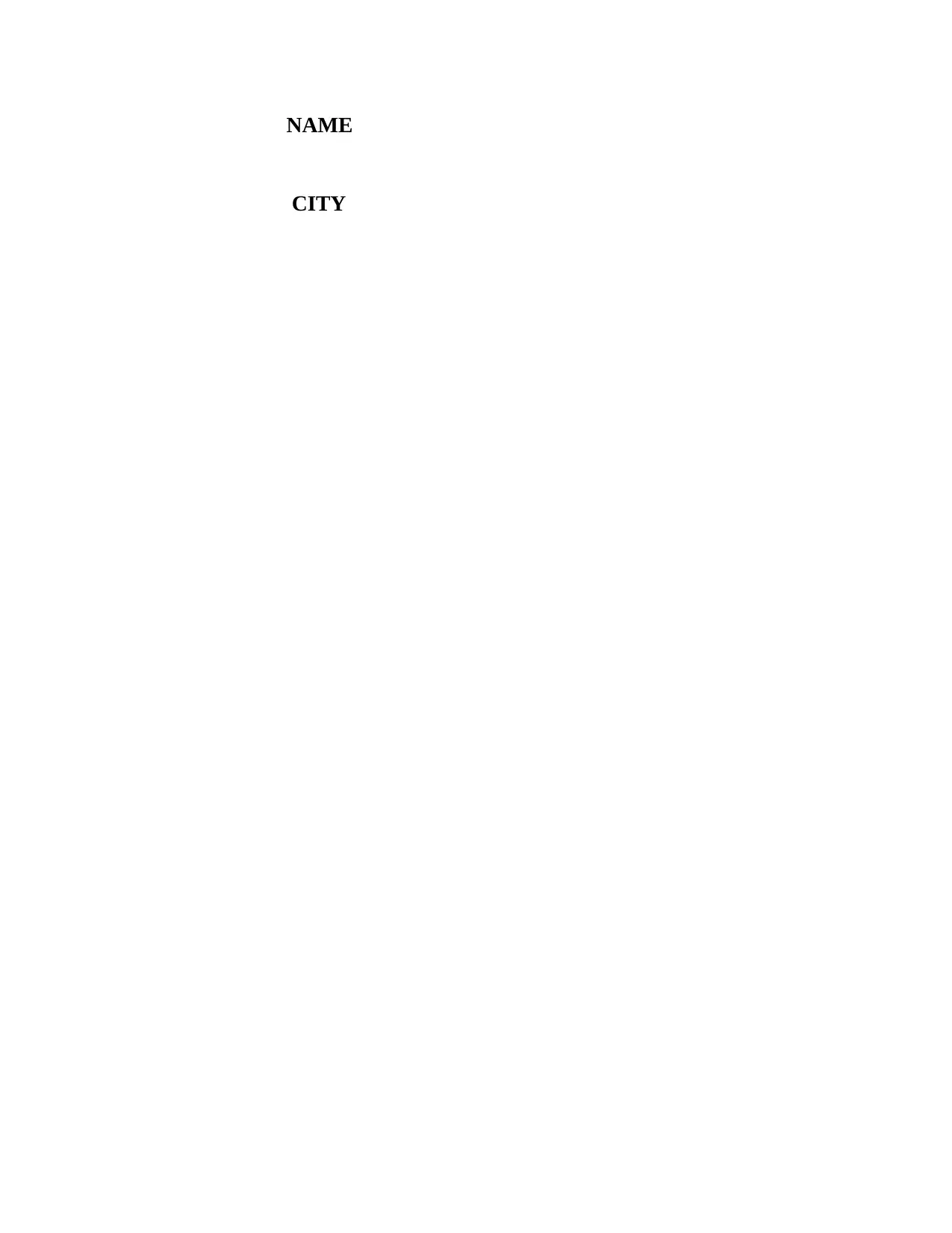
NAME
CITY
CITY
Paraphrase This Document
Need a fresh take? Get an instant paraphrase of this document with our AI Paraphraser
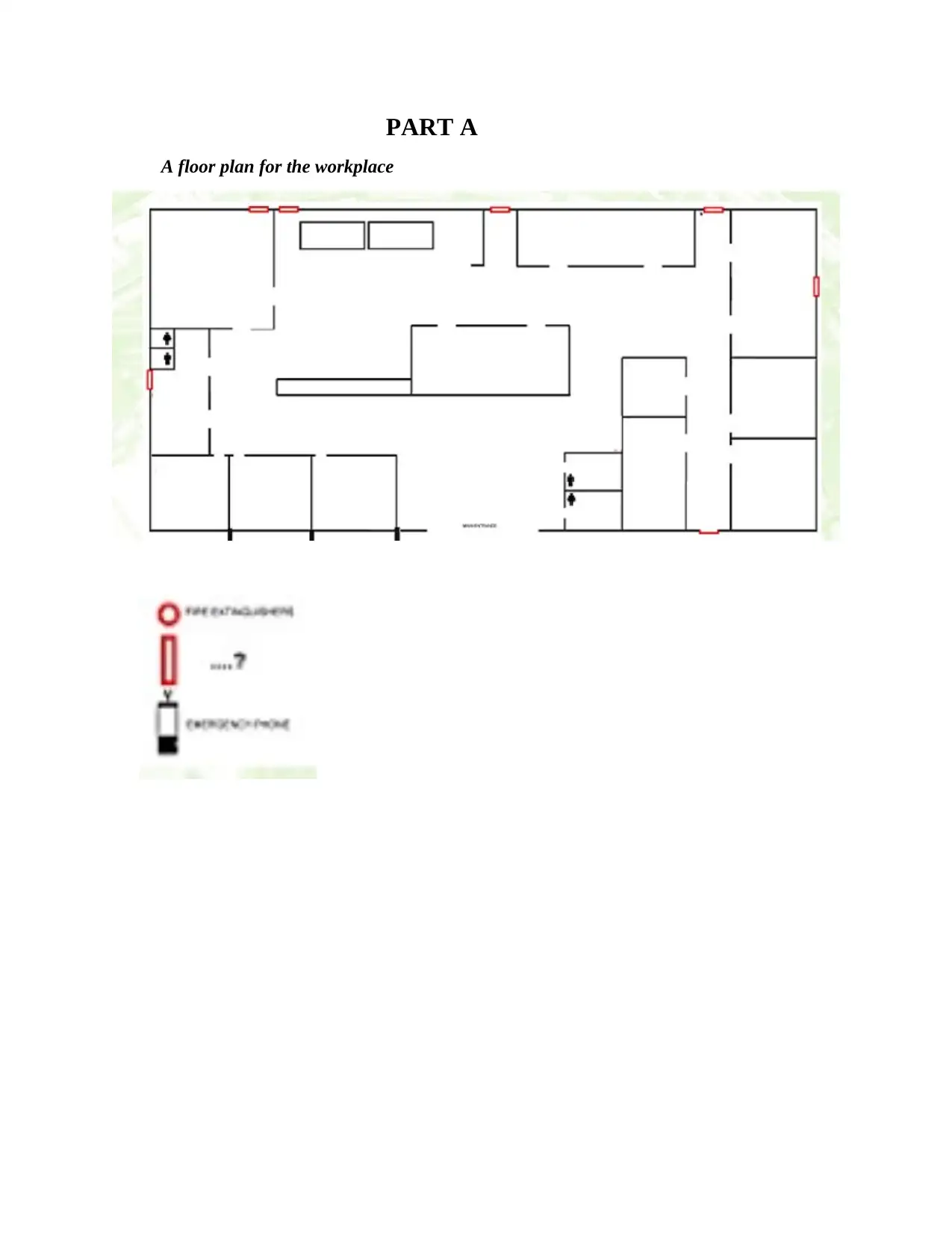
PART A
A floor plan for the workplace
A floor plan for the workplace
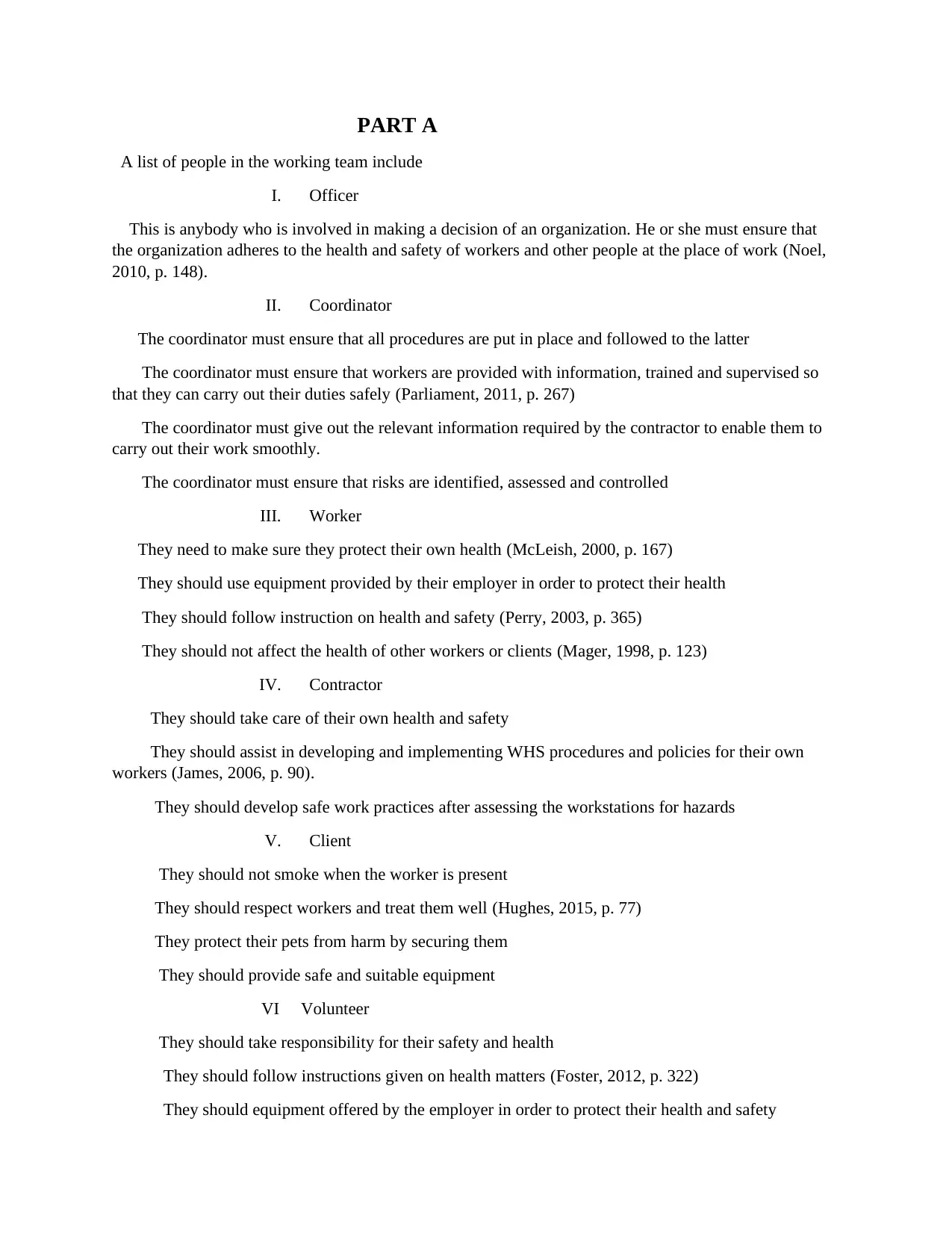
PART A
A list of people in the working team include
I. Officer
This is anybody who is involved in making a decision of an organization. He or she must ensure that
the organization adheres to the health and safety of workers and other people at the place of work (Noel,
2010, p. 148).
II. Coordinator
The coordinator must ensure that all procedures are put in place and followed to the latter
The coordinator must ensure that workers are provided with information, trained and supervised so
that they can carry out their duties safely (Parliament, 2011, p. 267)
The coordinator must give out the relevant information required by the contractor to enable them to
carry out their work smoothly.
The coordinator must ensure that risks are identified, assessed and controlled
III. Worker
They need to make sure they protect their own health (McLeish, 2000, p. 167)
They should use equipment provided by their employer in order to protect their health
They should follow instruction on health and safety (Perry, 2003, p. 365)
They should not affect the health of other workers or clients (Mager, 1998, p. 123)
IV. Contractor
They should take care of their own health and safety
They should assist in developing and implementing WHS procedures and policies for their own
workers (James, 2006, p. 90).
They should develop safe work practices after assessing the workstations for hazards
V. Client
They should not smoke when the worker is present
They should respect workers and treat them well (Hughes, 2015, p. 77)
They protect their pets from harm by securing them
They should provide safe and suitable equipment
VI Volunteer
They should take responsibility for their safety and health
They should follow instructions given on health matters (Foster, 2012, p. 322)
They should equipment offered by the employer in order to protect their health and safety
A list of people in the working team include
I. Officer
This is anybody who is involved in making a decision of an organization. He or she must ensure that
the organization adheres to the health and safety of workers and other people at the place of work (Noel,
2010, p. 148).
II. Coordinator
The coordinator must ensure that all procedures are put in place and followed to the latter
The coordinator must ensure that workers are provided with information, trained and supervised so
that they can carry out their duties safely (Parliament, 2011, p. 267)
The coordinator must give out the relevant information required by the contractor to enable them to
carry out their work smoothly.
The coordinator must ensure that risks are identified, assessed and controlled
III. Worker
They need to make sure they protect their own health (McLeish, 2000, p. 167)
They should use equipment provided by their employer in order to protect their health
They should follow instruction on health and safety (Perry, 2003, p. 365)
They should not affect the health of other workers or clients (Mager, 1998, p. 123)
IV. Contractor
They should take care of their own health and safety
They should assist in developing and implementing WHS procedures and policies for their own
workers (James, 2006, p. 90).
They should develop safe work practices after assessing the workstations for hazards
V. Client
They should not smoke when the worker is present
They should respect workers and treat them well (Hughes, 2015, p. 77)
They protect their pets from harm by securing them
They should provide safe and suitable equipment
VI Volunteer
They should take responsibility for their safety and health
They should follow instructions given on health matters (Foster, 2012, p. 322)
They should equipment offered by the employer in order to protect their health and safety
⊘ This is a preview!⊘
Do you want full access?
Subscribe today to unlock all pages.

Trusted by 1+ million students worldwide
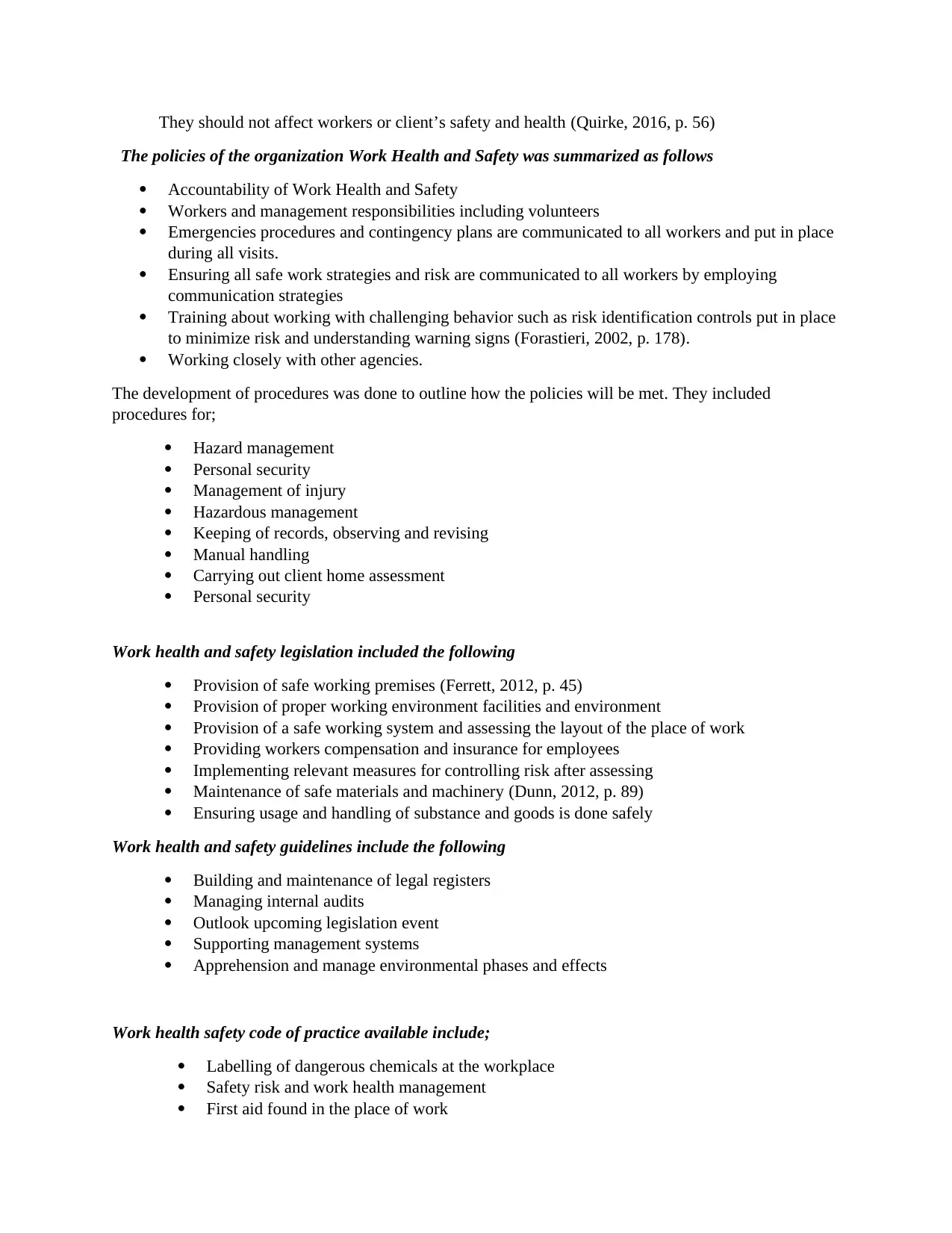
They should not affect workers or client’s safety and health (Quirke, 2016, p. 56)
The policies of the organization Work Health and Safety was summarized as follows
Accountability of Work Health and Safety
Workers and management responsibilities including volunteers
Emergencies procedures and contingency plans are communicated to all workers and put in place
during all visits.
Ensuring all safe work strategies and risk are communicated to all workers by employing
communication strategies
Training about working with challenging behavior such as risk identification controls put in place
to minimize risk and understanding warning signs (Forastieri, 2002, p. 178).
Working closely with other agencies.
The development of procedures was done to outline how the policies will be met. They included
procedures for;
Hazard management
Personal security
Management of injury
Hazardous management
Keeping of records, observing and revising
Manual handling
Carrying out client home assessment
Personal security
Work health and safety legislation included the following
Provision of safe working premises (Ferrett, 2012, p. 45)
Provision of proper working environment facilities and environment
Provision of a safe working system and assessing the layout of the place of work
Providing workers compensation and insurance for employees
Implementing relevant measures for controlling risk after assessing
Maintenance of safe materials and machinery (Dunn, 2012, p. 89)
Ensuring usage and handling of substance and goods is done safely
Work health and safety guidelines include the following
Building and maintenance of legal registers
Managing internal audits
Outlook upcoming legislation event
Supporting management systems
Apprehension and manage environmental phases and effects
Work health safety code of practice available include;
Labelling of dangerous chemicals at the workplace
Safety risk and work health management
First aid found in the place of work
The policies of the organization Work Health and Safety was summarized as follows
Accountability of Work Health and Safety
Workers and management responsibilities including volunteers
Emergencies procedures and contingency plans are communicated to all workers and put in place
during all visits.
Ensuring all safe work strategies and risk are communicated to all workers by employing
communication strategies
Training about working with challenging behavior such as risk identification controls put in place
to minimize risk and understanding warning signs (Forastieri, 2002, p. 178).
Working closely with other agencies.
The development of procedures was done to outline how the policies will be met. They included
procedures for;
Hazard management
Personal security
Management of injury
Hazardous management
Keeping of records, observing and revising
Manual handling
Carrying out client home assessment
Personal security
Work health and safety legislation included the following
Provision of safe working premises (Ferrett, 2012, p. 45)
Provision of proper working environment facilities and environment
Provision of a safe working system and assessing the layout of the place of work
Providing workers compensation and insurance for employees
Implementing relevant measures for controlling risk after assessing
Maintenance of safe materials and machinery (Dunn, 2012, p. 89)
Ensuring usage and handling of substance and goods is done safely
Work health and safety guidelines include the following
Building and maintenance of legal registers
Managing internal audits
Outlook upcoming legislation event
Supporting management systems
Apprehension and manage environmental phases and effects
Work health safety code of practice available include;
Labelling of dangerous chemicals at the workplace
Safety risk and work health management
First aid found in the place of work
Paraphrase This Document
Need a fresh take? Get an instant paraphrase of this document with our AI Paraphraser
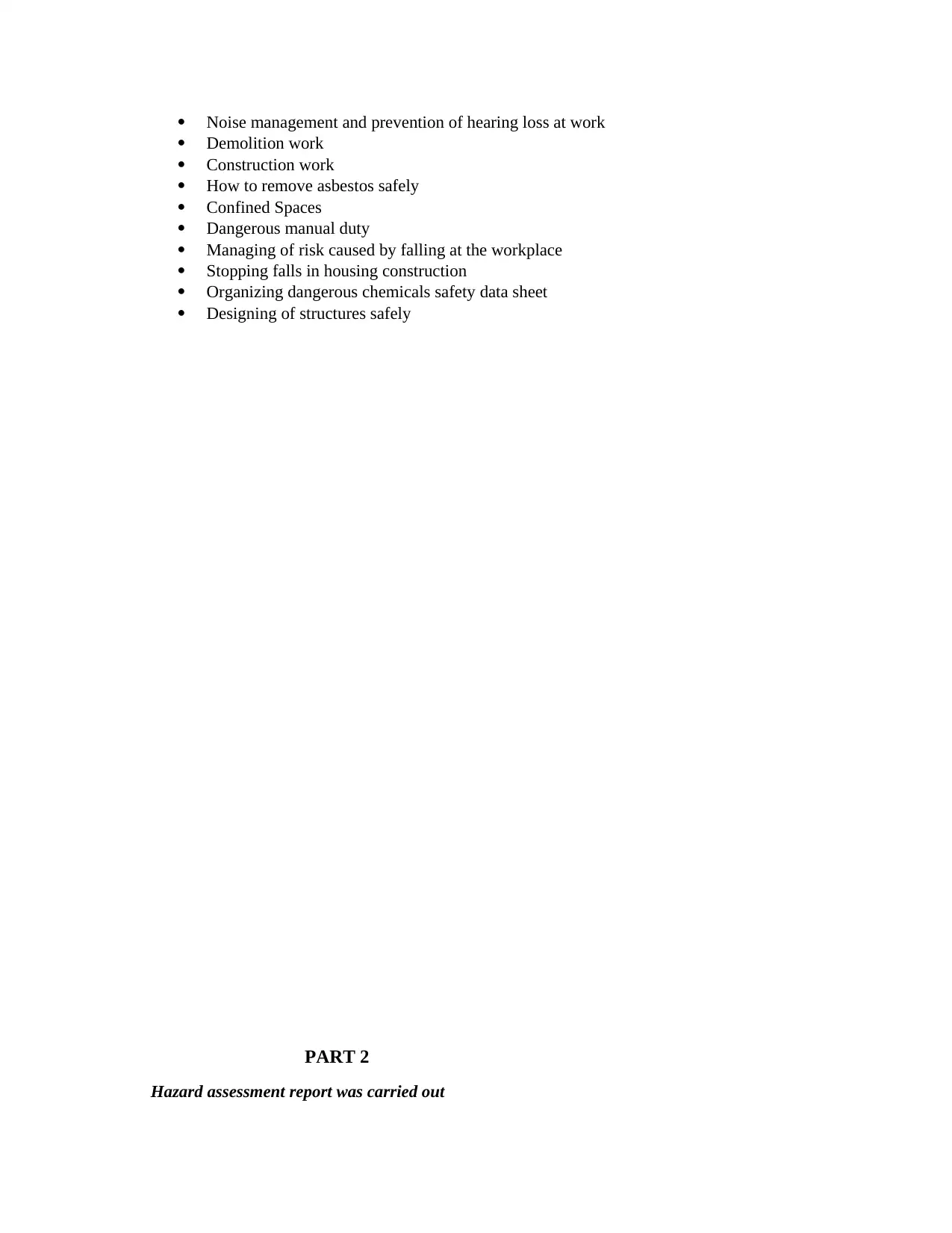
Noise management and prevention of hearing loss at work
Demolition work
Construction work
How to remove asbestos safely
Confined Spaces
Dangerous manual duty
Managing of risk caused by falling at the workplace
Stopping falls in housing construction
Organizing dangerous chemicals safety data sheet
Designing of structures safely
PART 2
Hazard assessment report was carried out
Demolition work
Construction work
How to remove asbestos safely
Confined Spaces
Dangerous manual duty
Managing of risk caused by falling at the workplace
Stopping falls in housing construction
Organizing dangerous chemicals safety data sheet
Designing of structures safely
PART 2
Hazard assessment report was carried out
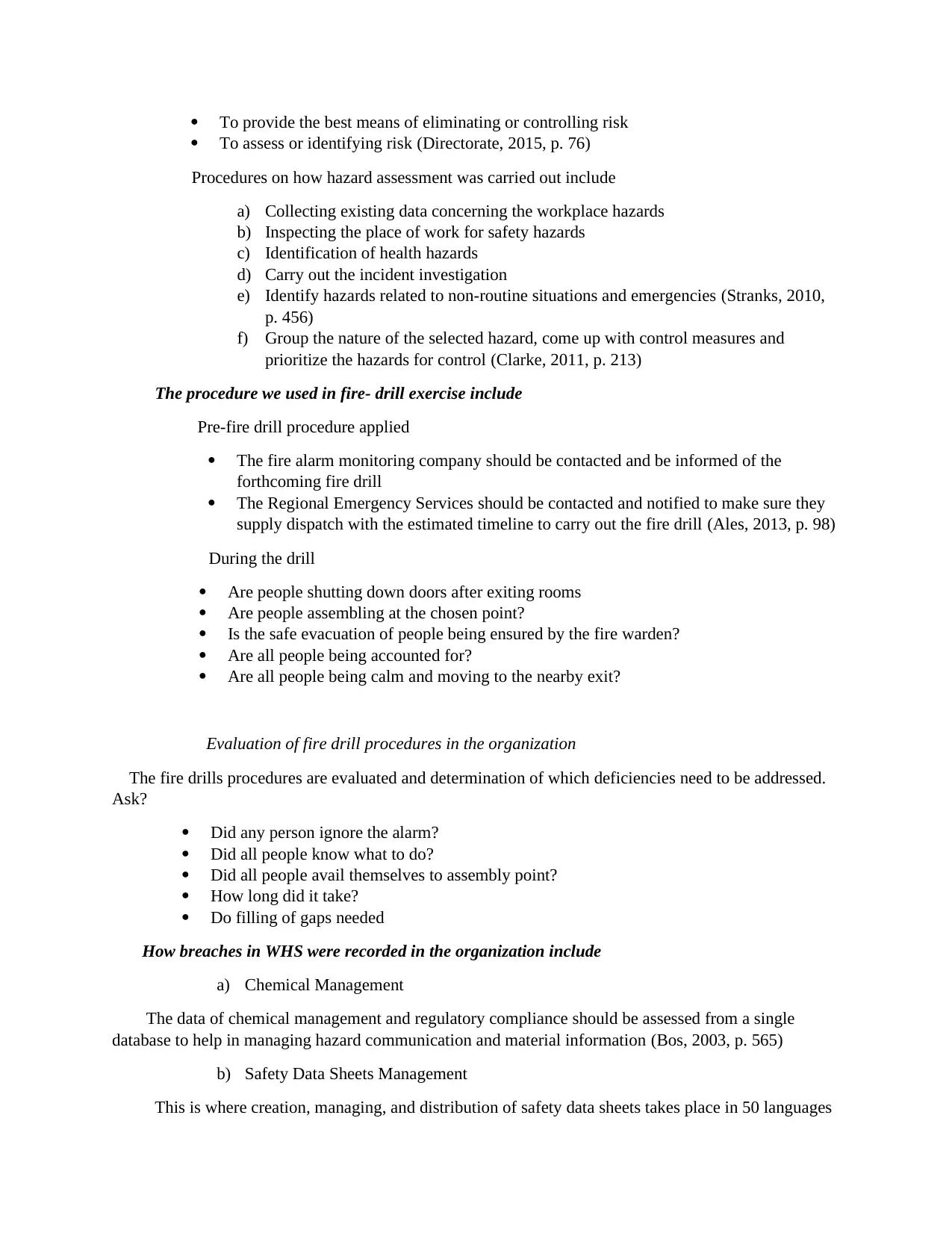
To provide the best means of eliminating or controlling risk
To assess or identifying risk (Directorate, 2015, p. 76)
Procedures on how hazard assessment was carried out include
a) Collecting existing data concerning the workplace hazards
b) Inspecting the place of work for safety hazards
c) Identification of health hazards
d) Carry out the incident investigation
e) Identify hazards related to non-routine situations and emergencies (Stranks, 2010,
p. 456)
f) Group the nature of the selected hazard, come up with control measures and
prioritize the hazards for control (Clarke, 2011, p. 213)
The procedure we used in fire- drill exercise include
Pre-fire drill procedure applied
The fire alarm monitoring company should be contacted and be informed of the
forthcoming fire drill
The Regional Emergency Services should be contacted and notified to make sure they
supply dispatch with the estimated timeline to carry out the fire drill (Ales, 2013, p. 98)
During the drill
Are people shutting down doors after exiting rooms
Are people assembling at the chosen point?
Is the safe evacuation of people being ensured by the fire warden?
Are all people being accounted for?
Are all people being calm and moving to the nearby exit?
Evaluation of fire drill procedures in the organization
The fire drills procedures are evaluated and determination of which deficiencies need to be addressed.
Ask?
Did any person ignore the alarm?
Did all people know what to do?
Did all people avail themselves to assembly point?
How long did it take?
Do filling of gaps needed
How breaches in WHS were recorded in the organization include
a) Chemical Management
The data of chemical management and regulatory compliance should be assessed from a single
database to help in managing hazard communication and material information (Bos, 2003, p. 565)
b) Safety Data Sheets Management
This is where creation, managing, and distribution of safety data sheets takes place in 50 languages
To assess or identifying risk (Directorate, 2015, p. 76)
Procedures on how hazard assessment was carried out include
a) Collecting existing data concerning the workplace hazards
b) Inspecting the place of work for safety hazards
c) Identification of health hazards
d) Carry out the incident investigation
e) Identify hazards related to non-routine situations and emergencies (Stranks, 2010,
p. 456)
f) Group the nature of the selected hazard, come up with control measures and
prioritize the hazards for control (Clarke, 2011, p. 213)
The procedure we used in fire- drill exercise include
Pre-fire drill procedure applied
The fire alarm monitoring company should be contacted and be informed of the
forthcoming fire drill
The Regional Emergency Services should be contacted and notified to make sure they
supply dispatch with the estimated timeline to carry out the fire drill (Ales, 2013, p. 98)
During the drill
Are people shutting down doors after exiting rooms
Are people assembling at the chosen point?
Is the safe evacuation of people being ensured by the fire warden?
Are all people being accounted for?
Are all people being calm and moving to the nearby exit?
Evaluation of fire drill procedures in the organization
The fire drills procedures are evaluated and determination of which deficiencies need to be addressed.
Ask?
Did any person ignore the alarm?
Did all people know what to do?
Did all people avail themselves to assembly point?
How long did it take?
Do filling of gaps needed
How breaches in WHS were recorded in the organization include
a) Chemical Management
The data of chemical management and regulatory compliance should be assessed from a single
database to help in managing hazard communication and material information (Bos, 2003, p. 565)
b) Safety Data Sheets Management
This is where creation, managing, and distribution of safety data sheets takes place in 50 languages
⊘ This is a preview!⊘
Do you want full access?
Subscribe today to unlock all pages.

Trusted by 1+ million students worldwide
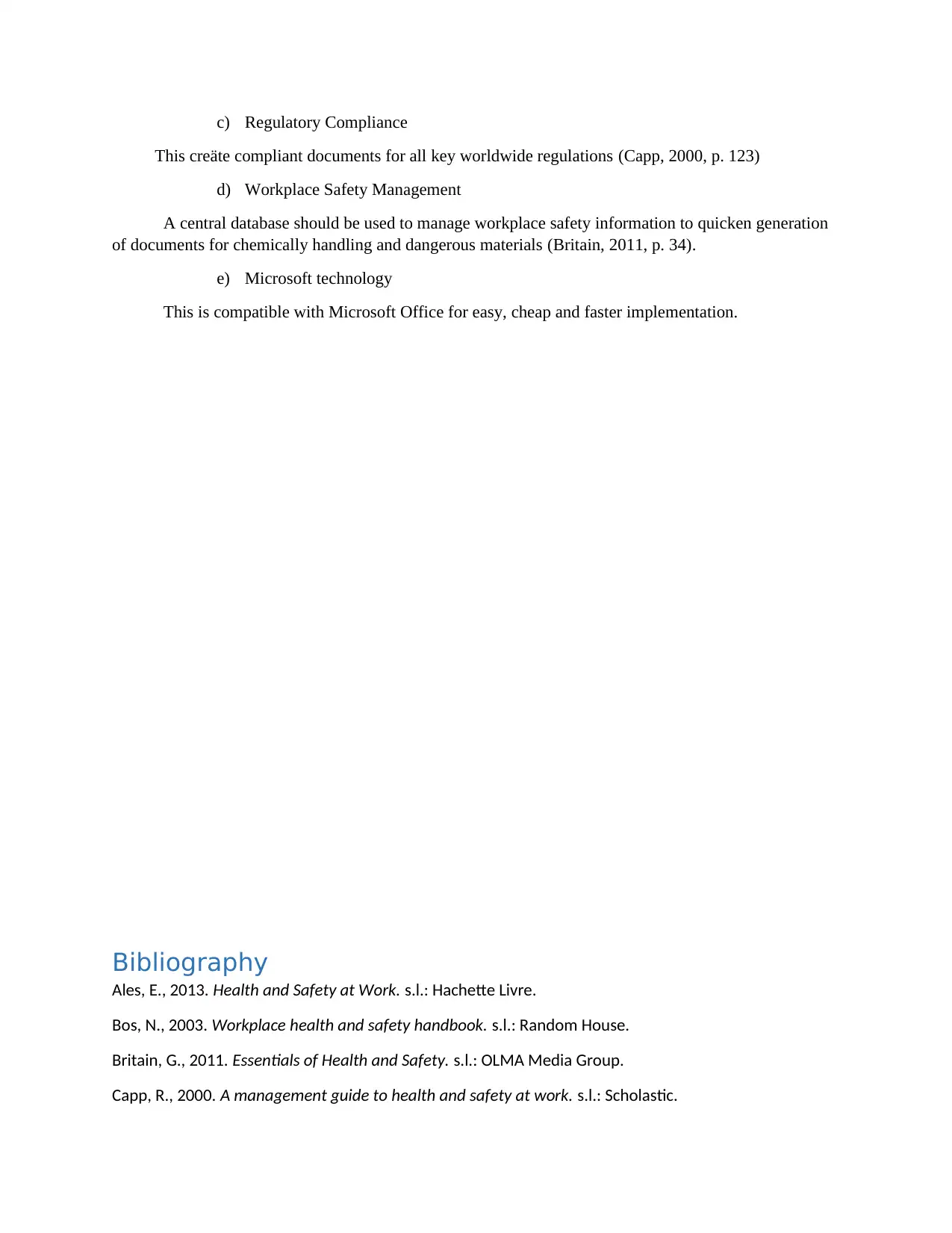
c) Regulatory Compliance
This creäte compliant documents for all key worldwide regulations (Capp, 2000, p. 123)
d) Workplace Safety Management
A central database should be used to manage workplace safety information to quicken generation
of documents for chemically handling and dangerous materials (Britain, 2011, p. 34).
e) Microsoft technology
This is compatible with Microsoft Office for easy, cheap and faster implementation.
Bibliography
Ales, E., 2013. Health and Safety at Work. s.l.: Hachette Livre.
Bos, N., 2003. Workplace health and safety handbook. s.l.: Random House.
Britain, G., 2011. Essentials of Health and Safety. s.l.: OLMA Media Group.
Capp, R., 2000. A management guide to health and safety at work. s.l.: Scholastic.
This creäte compliant documents for all key worldwide regulations (Capp, 2000, p. 123)
d) Workplace Safety Management
A central database should be used to manage workplace safety information to quicken generation
of documents for chemically handling and dangerous materials (Britain, 2011, p. 34).
e) Microsoft technology
This is compatible with Microsoft Office for easy, cheap and faster implementation.
Bibliography
Ales, E., 2013. Health and Safety at Work. s.l.: Hachette Livre.
Bos, N., 2003. Workplace health and safety handbook. s.l.: Random House.
Britain, G., 2011. Essentials of Health and Safety. s.l.: OLMA Media Group.
Capp, R., 2000. A management guide to health and safety at work. s.l.: Scholastic.
Paraphrase This Document
Need a fresh take? Get an instant paraphrase of this document with our AI Paraphraser
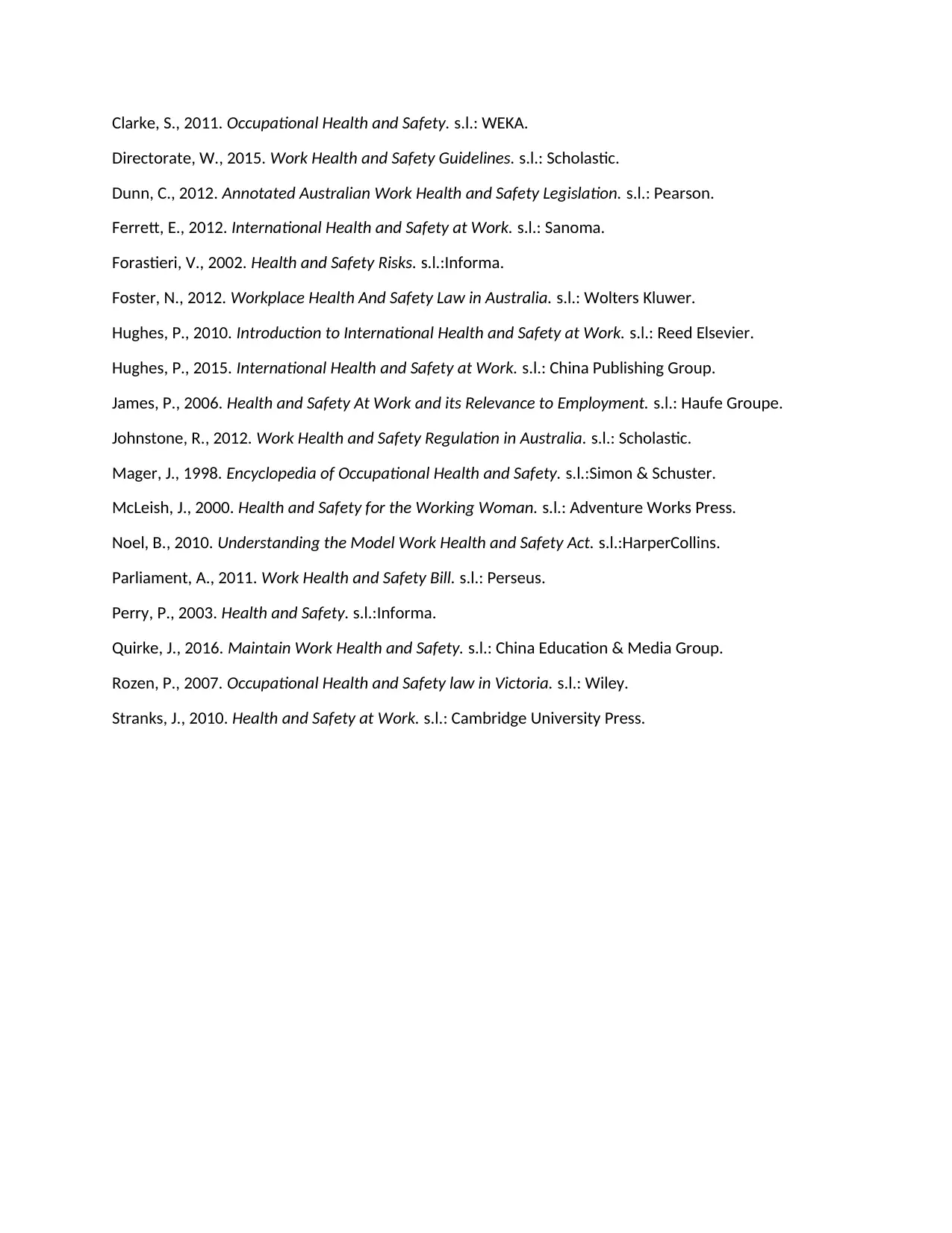
Clarke, S., 2011. Occupational Health and Safety. s.l.: WEKA.
Directorate, W., 2015. Work Health and Safety Guidelines. s.l.: Scholastic.
Dunn, C., 2012. Annotated Australian Work Health and Safety Legislation. s.l.: Pearson.
Ferrett, E., 2012. International Health and Safety at Work. s.l.: Sanoma.
Forastieri, V., 2002. Health and Safety Risks. s.l.:Informa.
Foster, N., 2012. Workplace Health And Safety Law in Australia. s.l.: Wolters Kluwer.
Hughes, P., 2010. Introduction to International Health and Safety at Work. s.l.: Reed Elsevier.
Hughes, P., 2015. International Health and Safety at Work. s.l.: China Publishing Group.
James, P., 2006. Health and Safety At Work and its Relevance to Employment. s.l.: Haufe Groupe.
Johnstone, R., 2012. Work Health and Safety Regulation in Australia. s.l.: Scholastic.
Mager, J., 1998. Encyclopedia of Occupational Health and Safety. s.l.:Simon & Schuster.
McLeish, J., 2000. Health and Safety for the Working Woman. s.l.: Adventure Works Press.
Noel, B., 2010. Understanding the Model Work Health and Safety Act. s.l.:HarperCollins.
Parliament, A., 2011. Work Health and Safety Bill. s.l.: Perseus.
Perry, P., 2003. Health and Safety. s.l.:Informa.
Quirke, J., 2016. Maintain Work Health and Safety. s.l.: China Education & Media Group.
Rozen, P., 2007. Occupational Health and Safety law in Victoria. s.l.: Wiley.
Stranks, J., 2010. Health and Safety at Work. s.l.: Cambridge University Press.
Directorate, W., 2015. Work Health and Safety Guidelines. s.l.: Scholastic.
Dunn, C., 2012. Annotated Australian Work Health and Safety Legislation. s.l.: Pearson.
Ferrett, E., 2012. International Health and Safety at Work. s.l.: Sanoma.
Forastieri, V., 2002. Health and Safety Risks. s.l.:Informa.
Foster, N., 2012. Workplace Health And Safety Law in Australia. s.l.: Wolters Kluwer.
Hughes, P., 2010. Introduction to International Health and Safety at Work. s.l.: Reed Elsevier.
Hughes, P., 2015. International Health and Safety at Work. s.l.: China Publishing Group.
James, P., 2006. Health and Safety At Work and its Relevance to Employment. s.l.: Haufe Groupe.
Johnstone, R., 2012. Work Health and Safety Regulation in Australia. s.l.: Scholastic.
Mager, J., 1998. Encyclopedia of Occupational Health and Safety. s.l.:Simon & Schuster.
McLeish, J., 2000. Health and Safety for the Working Woman. s.l.: Adventure Works Press.
Noel, B., 2010. Understanding the Model Work Health and Safety Act. s.l.:HarperCollins.
Parliament, A., 2011. Work Health and Safety Bill. s.l.: Perseus.
Perry, P., 2003. Health and Safety. s.l.:Informa.
Quirke, J., 2016. Maintain Work Health and Safety. s.l.: China Education & Media Group.
Rozen, P., 2007. Occupational Health and Safety law in Victoria. s.l.: Wiley.
Stranks, J., 2010. Health and Safety at Work. s.l.: Cambridge University Press.
1 out of 8
Related Documents
Your All-in-One AI-Powered Toolkit for Academic Success.
+13062052269
info@desklib.com
Available 24*7 on WhatsApp / Email
![[object Object]](/_next/static/media/star-bottom.7253800d.svg)
Unlock your academic potential
Copyright © 2020–2025 A2Z Services. All Rights Reserved. Developed and managed by ZUCOL.




